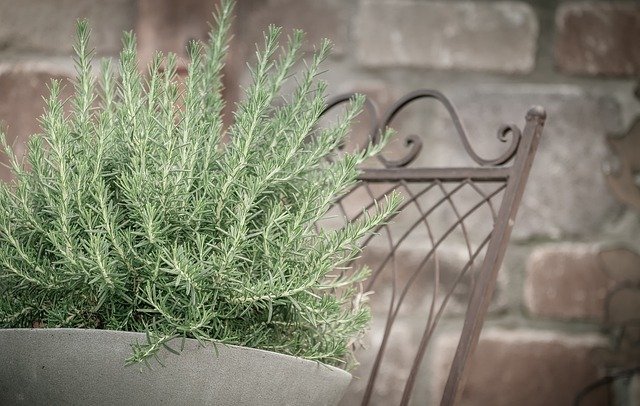Growing plants outside windows could be a very amusing activity to do. Just think about it. No matter where you’re living—house, apartment, condo, the elegant and enchanting colors of these plants will help add more aesthetic value to your house. Right now, you don’t even have to prepare for a special gardening land. You could easily make your dream garden come true!

Here are the best flowering plants for your window boxes along with some useful tips about how to create a perfect window box plant.
Table of Contents
What you need to know before growing flowers outside the window.
Growing plants outside windows have been stealing people’s attention for so long, especially for those who don’t have access to land. But before picking up some flowers to grow, the first thing you have to do is to measure your window.
A bigger window allows you to grow more plants. Remember to not overcrowd your plants since it can lead to weak growth as your plants will fight with each other to get nutrients.
Picking window boxes.
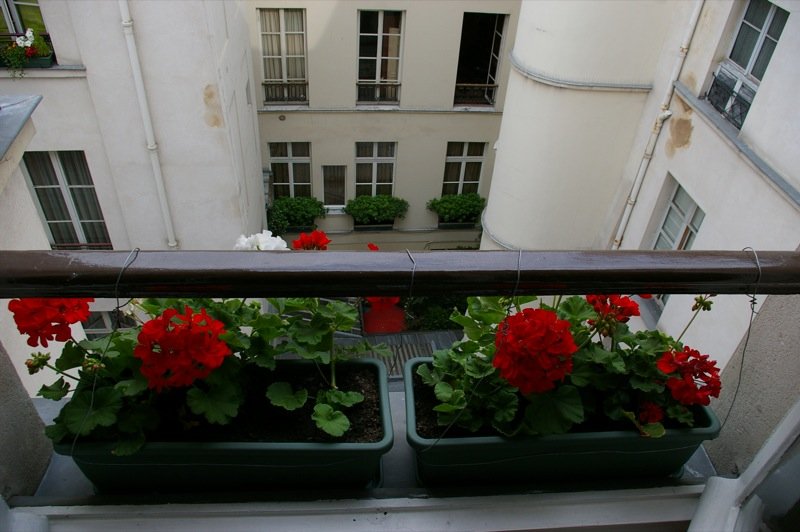
Once you take note, now it’s time to choose the box material. Window boxes come with a wide variety of choices. You can pick window boxes that are made either from plastic, wood, metal, rattan, ceramic, terra-cotta, or many others.
Usually, window boxes that are made from plastic are more prone to damage from prolonged exposure to sunlight. Window boxes from terra-cotta can easily break if you want to move them to another area, so you have to be extra careful with this one.
We recommend you use window boxes with good drainage holes that are lightweight and are not prone to rotting.
Consider the gardening style.
Choosing which gardening style is also essential. Do you like the modern minimalist style, the vintage retro style, or the joyful tropical-esque style? There are many gardening styles available. You can mix flowers type and colors, along with the color and decoration of your window boxes to match your personal and home style.
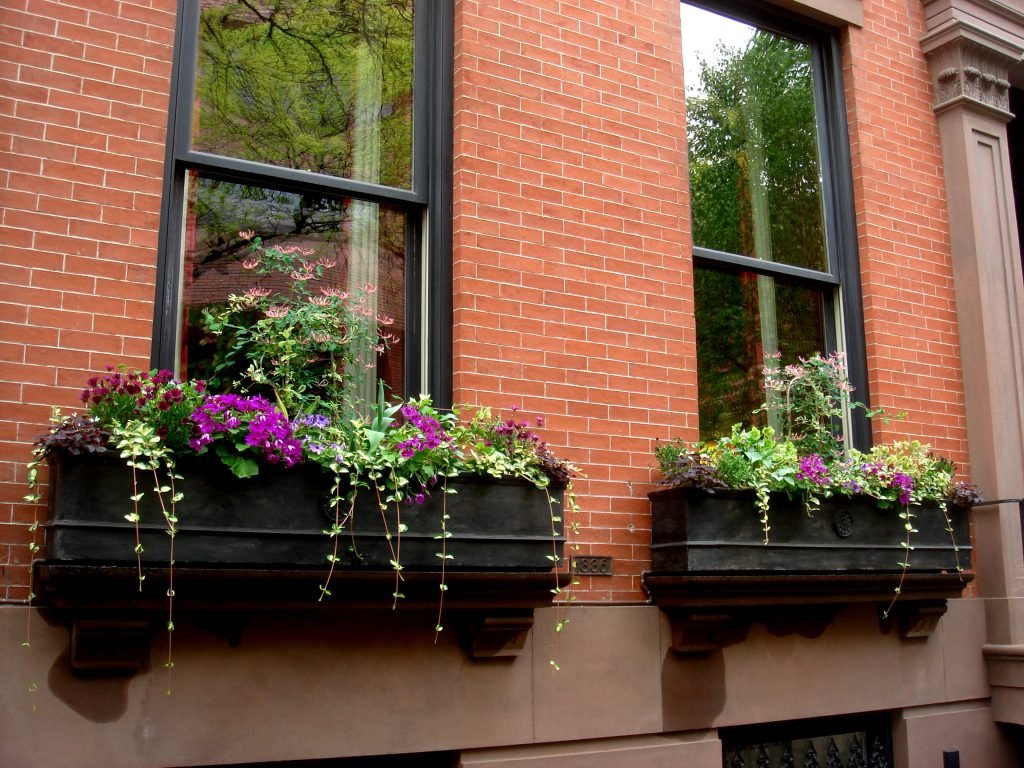
Always place your window box a little bit lower than your window. Your plants will grow, so you wouldn’t want it to block the access to outside view. A canopy to protect your window box plant from heavy rain or simply to add more artistic value could also be a great addition.
Consider the location.

Next, take a look at where your windows are heading. Is it south and west-facing, east-facing, or north-facing? Which hemisphere you are living in right now is also important. You may ask, why is it something you can leave behind? We all know that plants need sunlight to survive.
So, knowing how much sunlight your house gets is crucial. For instance, let’s say you’re living in the northern hemisphere. It would be challenging to grow plants that naturally need direct full sun in a north-facing window.
Measure how much sunlight your house gets:
-If you’re living in the northern hemisphere: East-facing windows provide bright and indirect sunlight. South and west-facing windows provide bright and direct sunlight. Meanwhile north facing windows get the lowest sunlight.
-If you’re living in the southern hemisphere: East-facing windows provide the same amount of sunlight as in the northern hemisphere. However, the south and west-facing windows get the lowest sunlight, while the north-facing windows get bright and direct sunlight.
Once all settled, now something you need to check out is, of course, which plants outside windows you would want to grow. We suggest you grow only shallow-rooted, small to medium-size, and low-to-medium-maintenance plants. Always plant flowers with the same sunlight and water needs.
25+ types of plants outside windows
Got all the tools yet? Now it’s time to pick your favorite flower! It could be small shrubs, ornamental flowering plants, succulents, or even hanging plants outside windows such as the most common devil’s ivy and sweet potato vine. But here, we gave you a list of uncommon yet dazzlingly beautiful window box plants.
For south and west-facing windows:
1. Mexican Heather or Elfin Herb (Cuphea hyssopifolia)
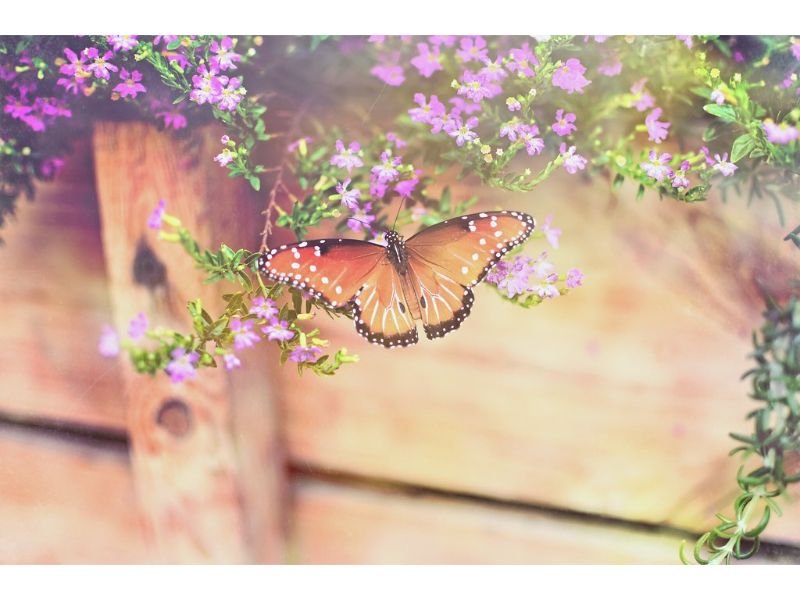
Origin: Mexico, Honduras, and Guatemala.
Type of plant: Small perennial shrub with edible leaves.
Plant size: Around 60 centimeters tall when matured.
Plant characteristics: Flowers are small, less than 1 inch with 6 or more pink, purple, white, or lavender petals and a yellow center. Leaves are elongated oval-shaped, dark green, and glossy with dark brown stems.
Maintenance: Low.
Toxicity level: None.
2. Mandevilla or Brazilian Jasmine (Mandevilla sanderi)

Origin: Brazil.
Type of plant: Tropical house plant vine that can be used to attract small animals such as pollinators and hummingbirds.
Plant size: Around 45 centimeters.
Plant characteristics: Flowers are small, around 3 to 6 inches each, with 4 to 5 bright pink, fuchsia, white, or burgundy red petals. The leaves are dark green and slightly bigger than the flowers’ size. Stems are bright green or slightly yellowish-green.
Maintenance: Medium.
Toxicity level: None.
3. Sunflowers (Helianthus)

Origin: America.
Type of plant: Annual and perennial herbs and flowering plants famous for their edible seeds and fruits, and as the symbol of joy in many cultures.
Plant size: Up to 3 meters in the wild, but decreases to only about 45 to 60 centimeters when grown in containers, pots, and window boxes.
Plant characteristics: Each flower has 7 to 20 petals with colors ranging from shades of yellow to orange, depending on its cultivars. Leaves are dark green, heart, or arrowhead-shaped with a rough texture.
Maintenance: Low.
Toxicity level: None.
Origin: Cape Town, South Africa.
4. Cape Jewels (Nemesia strumosa)
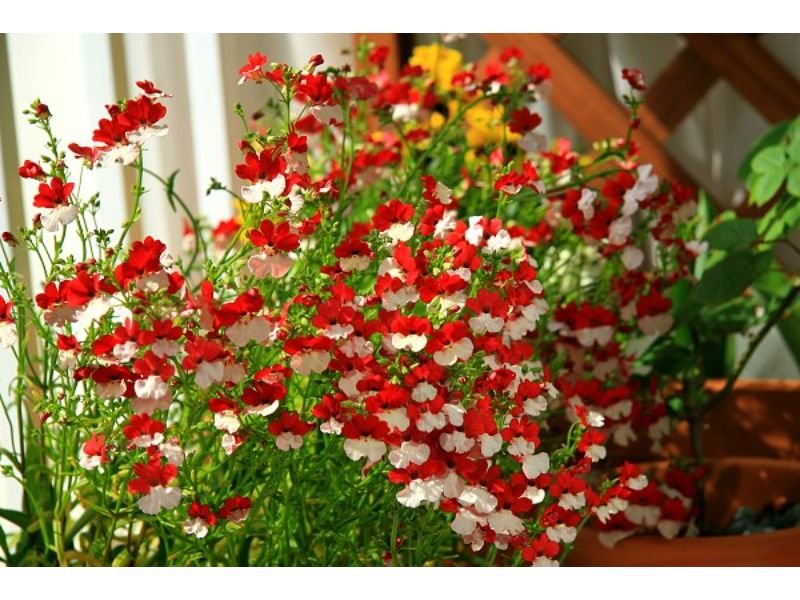
Type of plant: Annual bushy flowering plants. This one is non-edible.
Plant size: Around 25 to 30 centimeters tall.
Plant characteristics: Flowers are small-sized, less than 1 inch with 5 or more petals. Range of colors from shades of pink to yellow, red, white, orange, and lavender. Leaves are small, dark-green, and spear-shaped.
Maintenance: Medium.
Toxicity level: No.
5. Common Coreopsis or Tickseed (Coreopsis grandiflora)
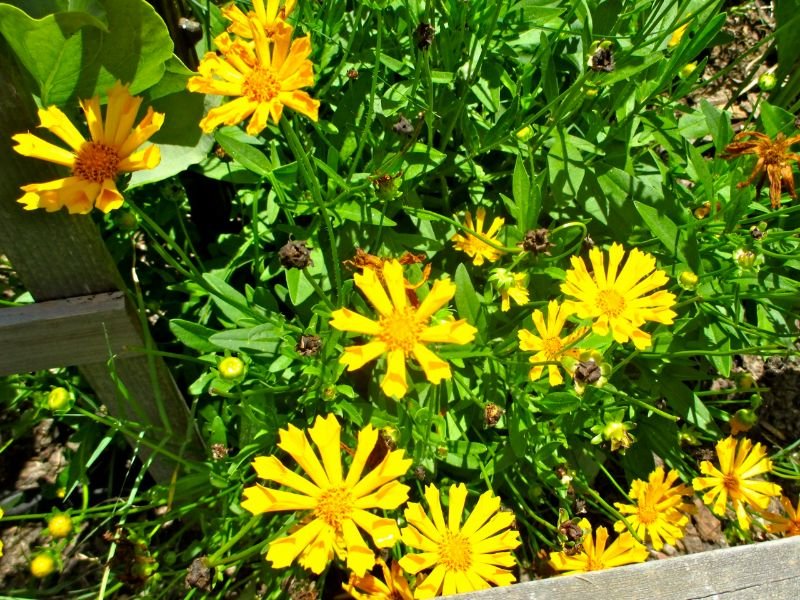
Origin: America and Canada.
Type of plant: Herbaceous perennial wildflower that is related to sunflowers (Asteraceae family).
Plant size: About 15 to 45 centimeters.
Plant characteristics: Flowers are small and medium-sized, with 7 to 20 bright yellow petals, aster-like shaped. Leaves are small, long, and dark green in the shape of elongated-oval.
Maintenance: Medium.
Toxicity level: No.
6. Windflower (Anemone)
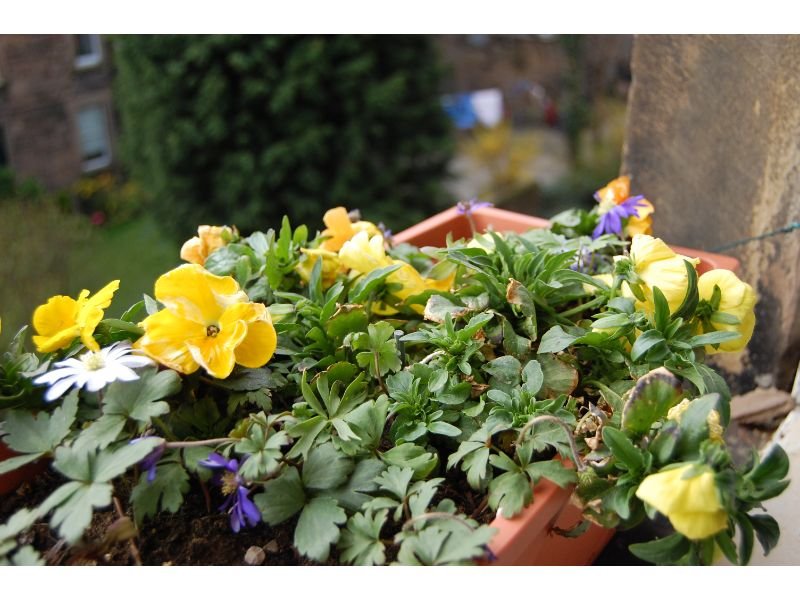
Origin: Russia, Central Asia, South America, North Africa.
Type of plant: Herbaceous perennial wildflower that is related to sunflowers (Asteraceae family).
Plant size: Around 30 to 45 centimeters tall.
Plant Characteristics: Flowers’s size range from 1 to 3 inches with a wide variety of colors from blue, red, white, lavender, shades of pink, and yellow or deep dark purple center. Leaves are bushy, dark green, and slightly cilantro-like.
Maintenance: Low.
Toxicity level: Medium, only if ingested.
7. Canary Island Marguerite (Argyranthemum foeniculaceum)
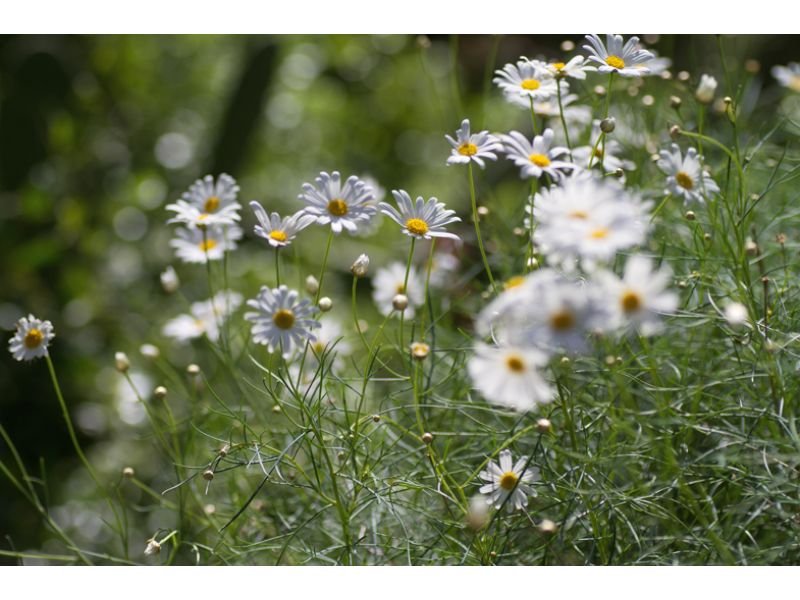
Origin: Canary Island.
Type of plant: Annual or perennial herbaceous plant. Often mistaken as common daisies.
Plant size: Can reach up to 100 centimeters tall when matured.
Plant characteristics: Flowers are daisy-like and shaped with a bright yellow center and white petals. Leaves are green, thin, and long.
Maintenance: Low.
Toxicity level: None.
8. Mexican Gem (Echeveria elegans)
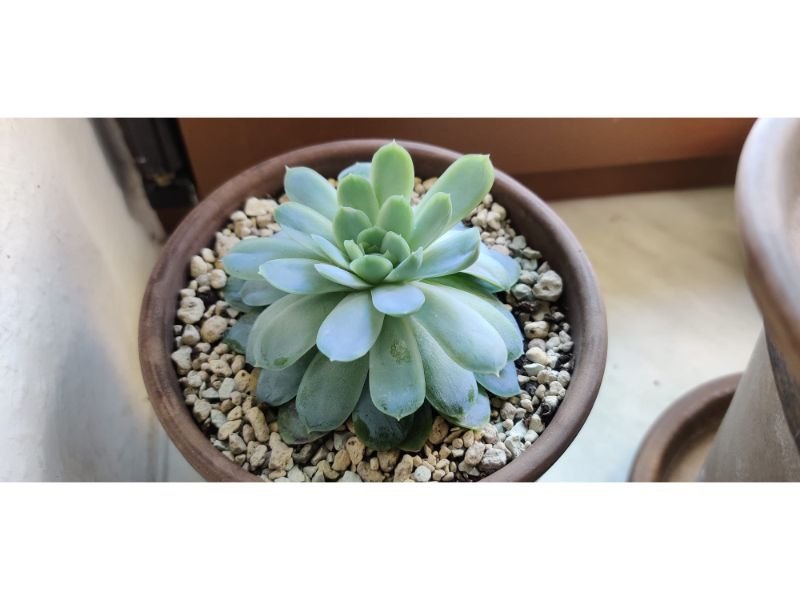
Origin: North-East Mexico.
Type of plant: Perennial small succulent known for its rose-like shape.
Plant size: Easy to care for and tiny, only about 25 centimeters, making it a wonderful addition to your window box plant.
Plant characteristics: Rosette-shaped succulent with yellowish-green, bluish-green, or grayish-green color and smooth, velvety-like texture. Flowers are small but rarely seen.
Maintenance: Low.
Toxicity level: None.
9. Hummingbird Mint (Agastache ‘Blue Fortune’)

Origin: A variegated version of Agastache from America and Asia.
Type of plant: Edible herbaceous perennial with edible leaves and fragrant flowers. If you are looking for an alternative to lavender, hummingbird mint could be your best choice.
Plant size: Can grow up to 90 centimeters.
Plant characteristics: Spike-like flowers with bluish-lavender or purplish-lavender color. Leaves are mint-like shaped with dark green or bright green color.
Maintenance: Low.
Toxicity level: None.
10. Weigela (Weigela florida)
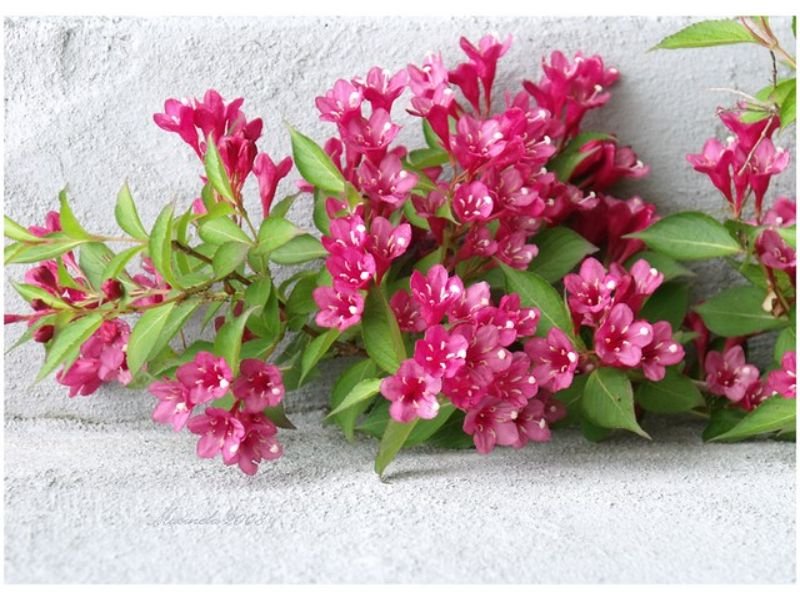
Origin: Korea, Japan, and North China.
Type of plant: Perennial and woody flowering bush related to the honeysuckle family. Weigela is non-toxic to both humans and pets but is not edible.
Plant size: Can grow up to around 240 centimeters in its natural habitat. Besides its tall size, weigela and its cultivars, like weigela ‘sunny fantasy’, are often used as window box plants for their striking colors and flowers. When planted in containers or small areas like window boxes, they usually grow up to around 100 meters only.
Plant characteristics: Flowers are small, trumpet-shaped with magenta, bright pale pink, or white color along with 2 to 3 white pistils per one flower. Leaves vary in color, from a combination of dark and bright green to deep dark purple, almost black, in several cultivars.
Maintenance: Low.
Toxicity level: None.
For east-facing windows:
1. Cineraria (Pericallis x hybrida)

Origin: Canary Islands.
Type of plant: Annual and perennial houseplant that loves to be grown in cool areas. Can be an alternative to other window box plants such as begonias, impatiens, and dianthuses.
Plant size: About 50 centimeters.
Plant characteristics: Flowers are tricolor, with daisy-like petals. It could be blue, lavender, pinkish-red, bright pink, white, or lavender with a dark brown center surrounded by white color. Leaves are arrowhead or heart-shaped, slightly rough with dark green color.
Maintenance: Medium.
Toxicity level: None.
2. Lobelia (Lobelia erinus)

Origin: Areas with higher altitudes.
Type of plant: Annual poisonous flowering plant.
Plant size: Shorter than cinerarias, with only about 15 to 22 centimeters high.
Plant characteristics: Lobelia has a unique 5 petals appearance where its 3 petals are much larger than the other 2. It has a tri-color combination with blue, pink, lavender, or white and yellow center surrounded by hints of white. Leaves come in green, small, thin, elongated egg-shapes that are narrow towards the end.
Maintenance: Low.
Toxicity level: Medium to humans. It might cause vomiting, diarrhea, and stomach aches.
3. Cascading Bacopa (Chaenostoma cordatum)
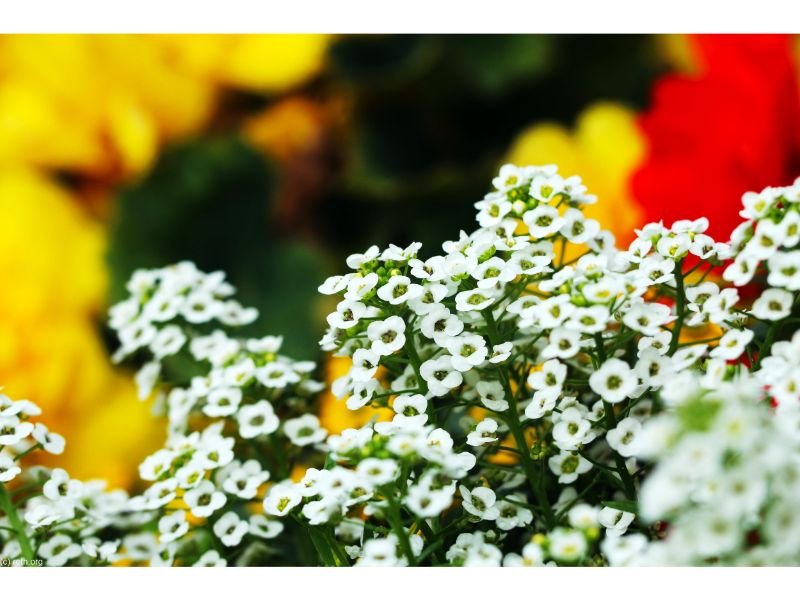
Origin: Southern Africa.
Type of plant: A simple perennial or annual herbaceous plant that comes in a variety of colors and sizes.
Plant size: Around 15 to 30 centimeters.
Plant characteristics: Each flower has 5 to 6 petals and an egg-yolk yellow-colored center. Petals’ color and size vary in each cultivar, from sakura pink, white, blue, lavender, and sunset. Sizes are either small (under 1 inch per flower) or big (around 4 to 10 inches per flower). Leaves are small, heart-shaped, and dark green.
Maintenance: Low.
Toxicity level: None.
4. Ligularia (Ligularia stenocephala)

Origin: China and spread widely to several East Asia countries.
Type of plant: Perennial and edible. A little fun fact, ligularia is commonly used in Korea as traditional medicine and as a food.
Plant size: Around 90 to 100 meters high. Can reach up to 180 centimeters in the wild.
Plant characteristics: Spiky flowers with lemon-yellow colors. Leaves are toothed-green, thin, and broad.
Maintenance: Medium.
Toxicity level: None.
5. Hellebores or Christmas Roses (Helleborus)
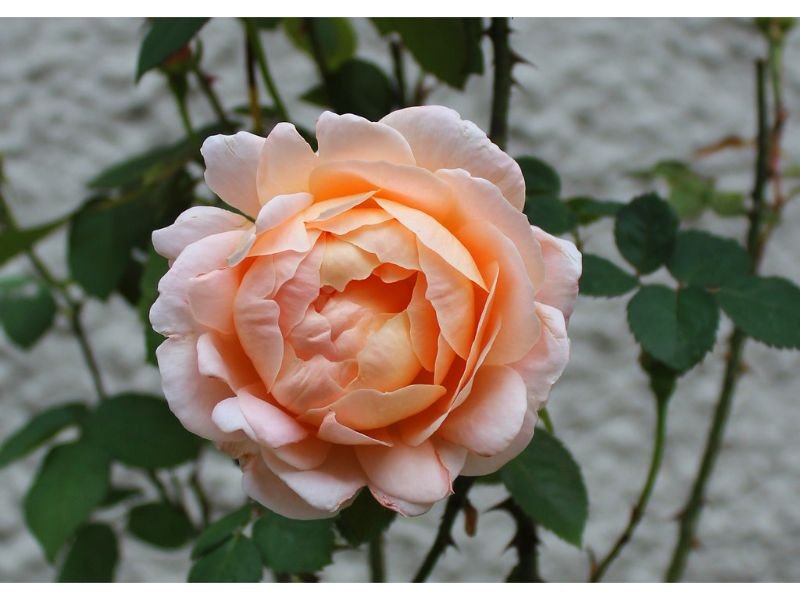
Origin: Morocco, Europe, Mongolia, the Korean peninsula, Russia’s Far East, Tibetan Plateau, Japanese island, and most parts of China.
Type of plant: Perennial. This plant has a unique story behind its common name, Christmas Roses. Hellebores are believed to be sprouted from the tears of a girl that felt saddened because she received no gift during Christmas. Interesting, isn’t it?
Plant size: Around 10 to 45 centimeters tall.
Plant characteristics: Flowers are slightly bell-shaped with 5 or more petals and yellow pistils. Petals can be very dark burgundy, white, shades of pink, lavender, to a color combination of pink at the center and white at the outer of each petal. Leaves are dark green, long, and thin.
Maintenance: Low.
Toxicity level: None.
6. Birdfoot Violet (Viola pedata)
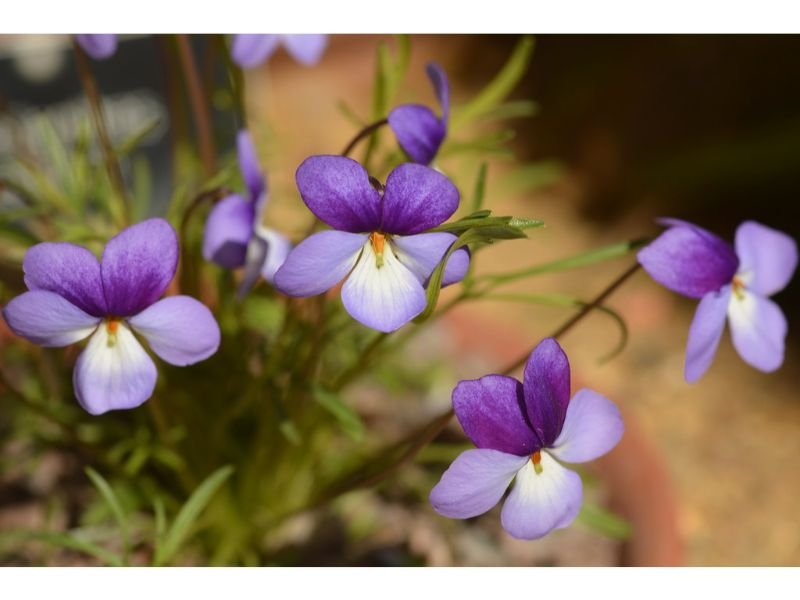
Origin: Sandy areas in the central and eastern parts of Northern America.
Type of plant: Herbaceous perennial wildflower. The name ‘bird foot’ comes from its leaf shape, which looks like a tiny bird’s foot. Unique, beautiful, and small-sized, they could be one of the best plants outside windows!
Plant size: Around 10 to 20 centimeters.
Plant characteristics: Tiny bluish-violet or purple 4 or 5 petals flowers with white color near the center at 1 petal and yellow pistils. The leaves are green, long, thin, and narrow at the end.
Maintenance: Medium.
Toxicity level: None.
7. Cupid’s Bow (Achimenes)

Origin: South and Central America.
Type of plant: This perennial non-edible plant has a weeping growth habit. If you are in search of hanging plants outside the window, this winsome flower is your answer.
Plant size: About 30 centimeters tall.
Plant characteristics: Flowers have 4 or 5 petals with diverse colors of purple, deep pink, white, or red. Each flower has bright yellow pistils and either white, dark burgundy, or yellow center. The leaves are medium-sized with silverish-green color and velvety texture.
Maintenance: Medium.
Toxicity level: None.
8. Cupflower (Nierembergia linariifolia)

Origin: Central South America.
Type of plant: Perennial if grown in its natural habitat but annual if grown in any continent (except the Arctic).
Plant size: Around 15 to 30 centimeters.
Plant characteristics: Flowers are small to medium size, around 3 to 8 centimeters, with dark bluish-purple, white, or purple petals, and bright yellow pistils. Leaves are bushy, dark green, and rosemary-like.
Maintenance: Low.
Toxicity level: None.
9. Black-eyed Susan Vine (Thunbergia alata)
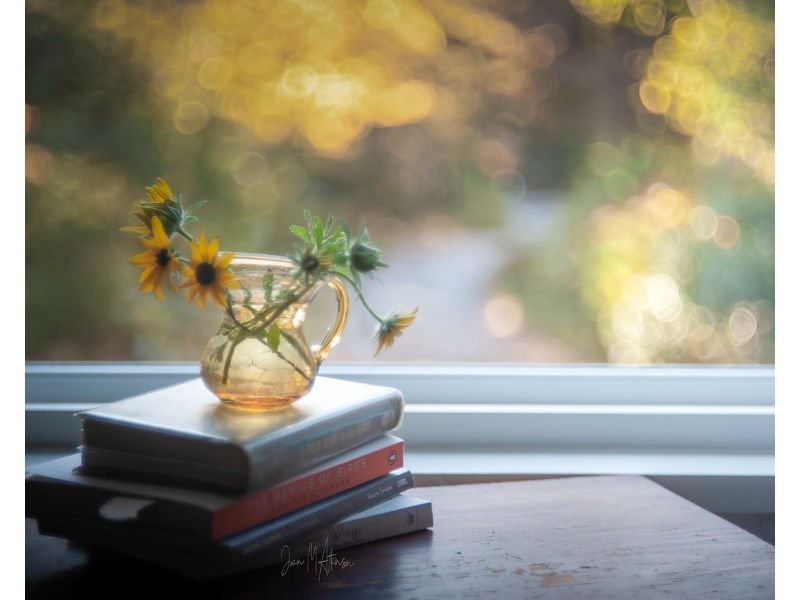
Origin: East Africa.
Type of plant: An annual tropical and climbing flowering plant. Black-eyed susan vine can be perennial if grown in hardiness zones 10 and 11.
Plant size: About 90 to 240 centimeters, but might grow shorter if grown in containers and window boxes.
Plant characteristics: Each flower has 5 petals with a black center. Colors vary from yellow to orange. The size of the flowers also varies from about 3 to 8 centimeters. Leaves are heart-shaped and dark green at the upper side, while pale-colored at the bottom side with visible veins.
Maintenance: Low.
Toxicity level: None.
10. Vanda Orchid (Vanda)
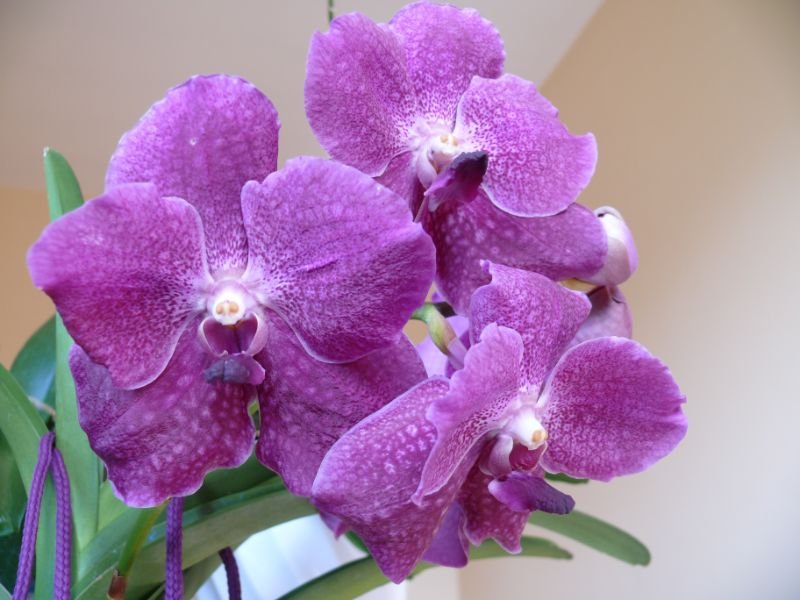
Origin: Tropical and subtropical regions of Asia such as India, and the Pacific.
Type of plant: Herbaceous perennial that has been grown as a houseplant. It also has a fragrant smell and can be used as a mix of perfume.
Plant size: About 15 to 25 centimeters when matured.
Plant characteristics: Each flower has 4 to 5 petals and grows upright, forming a stalk of flowers. The colors are yellow, dark purple, lavender, orange, maroon, white, or bluish-lavender. The leaves are thin, and long, and have a slightly glossy look with dark green color.
Maintenance: Medium.
Toxicity level: None.
For north-facing windows:
1. Bugleweed (Ajuga reptans)

Origin: Northern Africa, Europe, and Southwestern Asia.
Type of plant: Perennial herbaceous plant known for its many cultivars.
Plant size: About 15 to 20 centimeters, each cultivar has a different height when matured.
Plant characteristics: Colonies of flowers forming an individual spike, with the size of each flower about 8 to 16 centimeters. Colors are either lavender, bluish-lavender, or white. Leaves are glossy, about 8 to 10 centimeters long, oval-shaped, and purple or green with a splash of gray.
Maintenance: Medium.
Toxicity level: None.
2. Creeping Phlox (Phlox subulata)
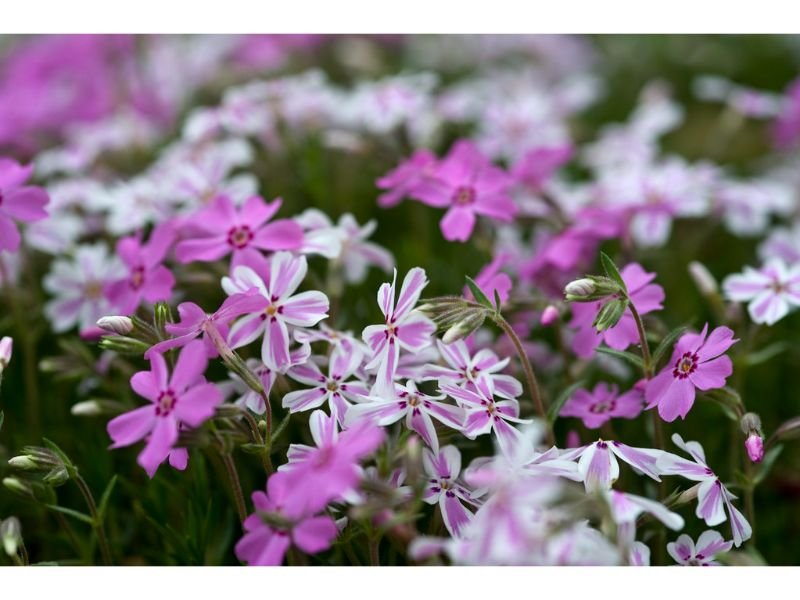
Origin: Central and Eastern parts of Canada and America.
Type of plant: Herbaceous perennial grown for its attractive colors.
Plant size: About 8 to 40 centimeters high but can spread as wide as 60 centimeters.
Plant characteristics: Flowers are small, no more than 2 centimeters, and they grow vigorously. Colors can be individual or a combination of pink, purple, white, blue, dark red, or lavender. Leaves are long, linear-shaped with a yellowish-green color.
Maintenance: Low.
Toxicity level: None.
3. Lipstick Vine (Aeschynanthus radicans)
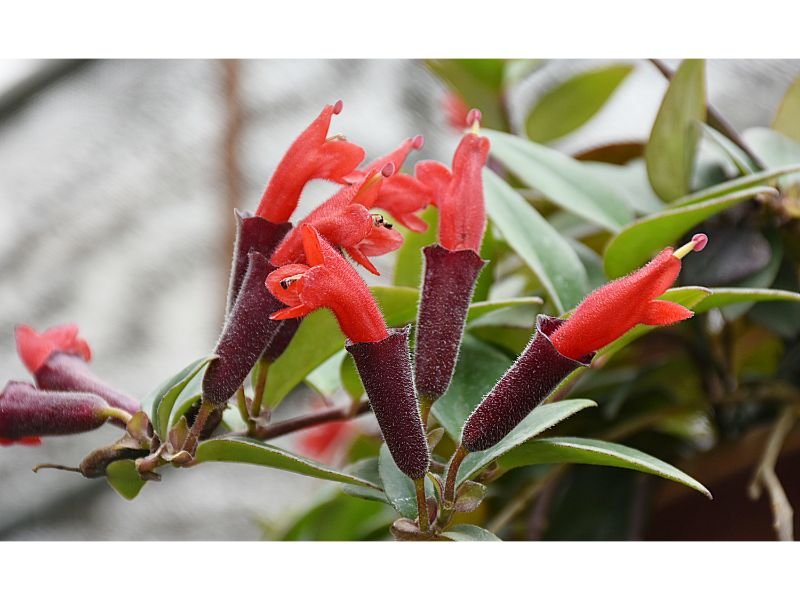
Origin: Thailand Peninsula, Central and West Malaysia
Type of plant: Houseplant perennial vine known for its flowers that attract pollinators and hummingbirds in the wild.
Plant size: About 50 centimeters high and the size may decrease if grown in warmer conditions.
Plant characteristics: Flowers are red or burgundy, tubular-shaped with velvety looks and feel. The smell of this flower may be unpleasant for some. The leaves are green, thick, and elongated oval-shaped.
Maintenance: Low.
Toxicity level: None.
4. Watermelon Pilea (Pilea cadierei)

Origin: Vietnam and China.
Type of plant: Perennial herbaceous house plant. Also known as ‘aluminum plant’ for its leaf color.
Plant size: Around 30 centimeters.
Plant characteristics: Most fascinating thing about this plant that would steal your attention is the leaves. The leaves are elliptical-shaped with a mix of dark green color and silverish-gray, forming a pattern that looks like a watermelon.
Maintenance: Low.
Toxicity level: Low for humans and pets, only if the leaf part is ingested.
5. Wishbone Flower (Torenia fournieri)

Origin: Asia.
Type of plant: Annual ornamental house plant known as the symbol of affection, attraction, and joy. This plant has no fruit.
Plant size: Around 16 to 30 centimeters.
Plant characteristics: Flowers are tubular-shaped with a color combination of white and purple or dark blue on the outer side of each petal. Each flower has bright yellow pistils. Leaves are green, glossy, and oval-shaped.
Maintenance: Medium.
Toxicity level: None.
6. Painted Nettle (Coleus scutellarioides)

Origin: Africa and South-East Asia.
Type of plant: Annual and herbaceous perennial with more than 10 cultivars.
Plant size: Around 30 centimeters for the smallest cultivar to 90 centimeters.
Plant characteristics: Coleus is grown for its leaves, which are oblong-shaped and around 7 centimeters wide and 15 centimeters long. It has wide color variation and can be a mix of yellowish-golden, pink, burgundy, purple, dark purple, copper brown, orange, green, or sometimes white.
Maintenance: Low.
Toxicity level: Low, may cause skin irritation.
7. Yellow Trout Lily (Erythronium americanum)

Origin: Canada and America.
Type of plant: Perennial wildflower. Yellow trout lily is known as part of the plant that is resistant to pests and diseases.
Plant size: About 10 to 16 centimeters.
Plant characteristics: It has yellow, bell-shaped flowers with 5 or 6 petals that curve backward as it blooms. Leaves are elliptical-shaped with colors of green, dark brown, or dark purple.
Maintenance: Low.
Toxicity level: None.
8. Pink Heuchera (Heuchera ‘Berry Smoothie’)
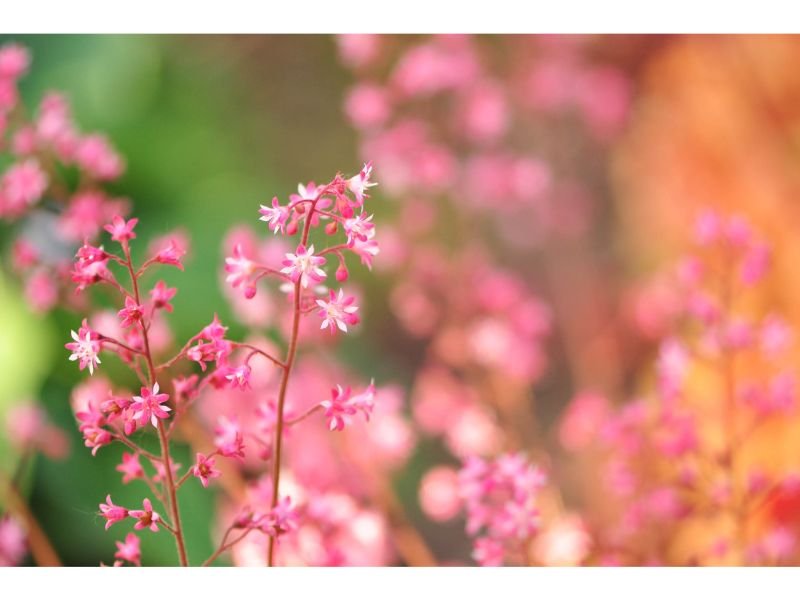
Origin: America.
Type of plant: Another perennial ornamental plant grown for its leaves and color.
Plant size: About 30 to 46 centimeters tall.
Plant characteristics: Simple leaf shape with shades of pink, purple, and red colors along with dark pink veins. Good addition if you like romantic theme gardens.
Maintenance: Low.
Toxicity level: None.
9. German Primrose (Primula obconica)
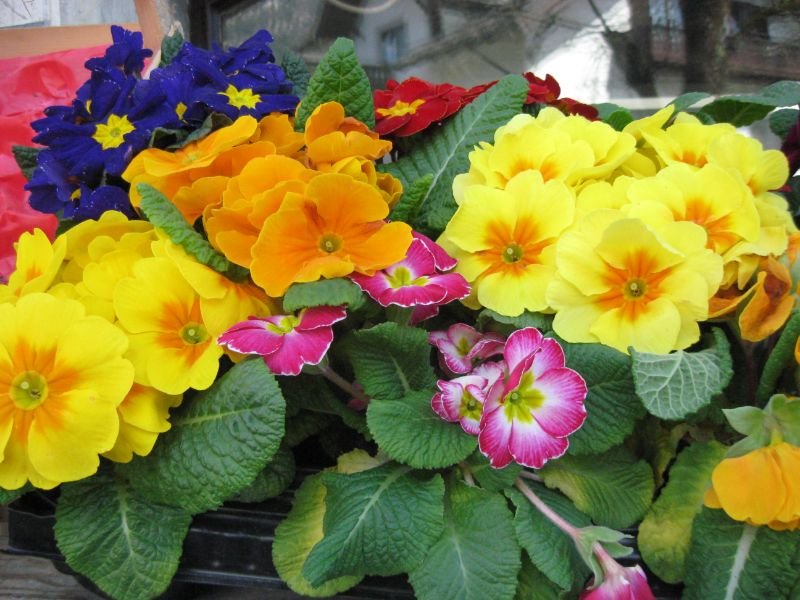
Origin: China.
Type of plant: Perennial and annual flowering houseplant.
Plant size: Around 20 to 30 centimeters.
Plant characteristics: Tiny, funnel-shaped flowers with 4 to 5 bright red, white, purple, and pink colored petals, along with a yellow or greenish-yellow center. Leaves are elliptical-shaped or heart-shaped and velvety with hair presence.
Maintenance: Medium.
Toxicity level: Medium, only if touched. Skin allergic symptoms may occur.
10. Oxlip (Primula elatior)
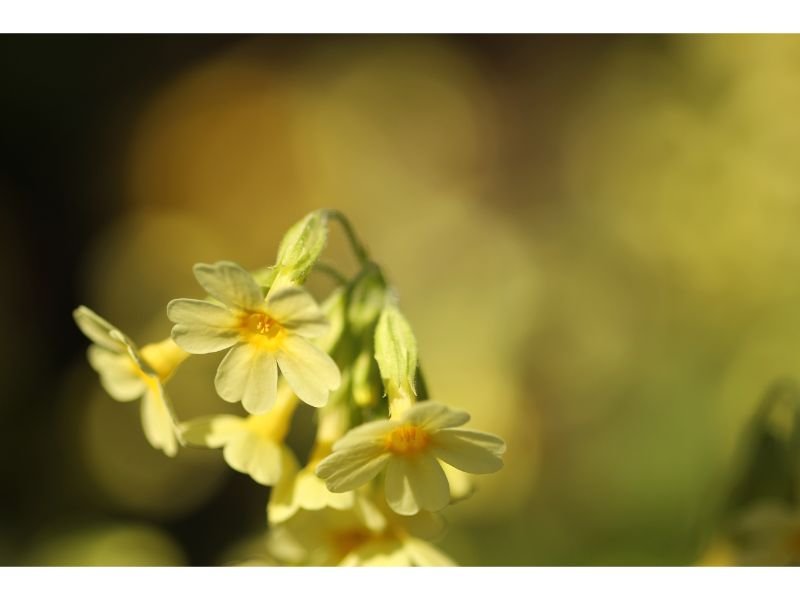
Origin: Sweden and several regions of Europe.
Type of plant: Perennial flowering plant usually found in damp and woody areas.
Plant size: Around 10 to 20 centimeters.
Plant characteristics: It has small yellow, golden, or pale yellow fragrant flowers, about 3 to 8 centimeters in size. Leaves are bigger, with a dark green or yellowish-green color.
Maintenance: Low.
Toxicity level: None.
Conclusion.
Overall, growing plants outside windows are great for aesthetic value and surely can be a tool for beginner gardeners to learn about gardening. By using window boxes, anyone could have their garden without having to worry about space. Just keep in mind basic things such as your window and house location, preferred style, and which plants interest you the most–then you’re all ready to build your window box garden!

New author in the hood. Loves gardening and flowers are my spirit animals (yes I know they are not animals but I insist). I will be covering most of the flowers’ topics here and occasionally random though as well.





